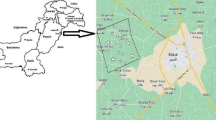Abstract
This study reports on the concentration and distribution pattern of organochlorine pesticides in soil and water samples collected from obsolete pesticide stores in three provinces of Pakistan and analyzed on capillary gas chromatography/electron capture detection. The data for soil and water samples were highly variable as samplings were done from diversified locations. The soil samples mainly contained DDTs followed by lindane and heptachlor. The contamination levels in North West Frontier Province (NWFP), Punjab, and Sindh were in ranges of 247–9,157 mg kg−1, 214–10,892 mg kg− 1, and 86–1,139 mg kg − 1, respectively. In water, residue range levels were 0–15.17 (median 0.29) μg L − 1, 0.25–0.78 (median 0.36) μg L − 1, and 0.11–0.83 (median 0.21) μg L − 1 in NWFP, Punjab, and Sindh, respectively.
Similar content being viewed by others
References
Ahad, K., Ashiq, M., Mehboob, F., Sattar, S., & Ahmad, I. (2006). Pesticide residues in Rawal Lake, Islamabad, Pakistan. Bulletin of Environmental Contamination and Toxicology, 76, 463–470. doi:10.1007/s00128-006-0944-8.
Heinisch, E., & Klein, S. (1991). Contamination of surface waters, sediments and biota from pesticide manufacturing factory. In M. L. Richardson (Ed.), Chemistry, agriculture and the environment (pp. 255–290). Cambridge: The Royal Society of Chemistry.
Hites, R. K., & Day, H. R. (1992). Unusual persistence of DDT in some western USA soils. Bulletin of Environmental Contamination and Toxicology, 48, 259–264.
Jabbar, A., & Mallick, S. (1994). Pesticide and environment situation in Pakistan. Working Paper Series # 19, Sustainable Development Policy Institute, Islamabad.
Jan, M. R., Shah, J., Khawaja, M. A., & Gul, K. (2008). DDT residue in soil and water in and around abandoned DDT manufacturing factory. Environmental Monitoring and Assessment (in press). doi:10.1007/s10661-008-0415-2.
Kafi, A., & Baig, M. M. H. (1987). Needs and prospects for manufacturing pesticides in Pakistan. Department of Plant Protection, Karachi and Federal Pesticide Laboratory, PARC, Karachi.
Kalantzi, Q. I., Alcock, R. E., Joneston, P. A., Santillo, D., Stringer, R. L., Thomas, G. O., et al. (2001). The global distribution of PCBs and organochlorine pesticides in butter. Environmental Science & Technology, 35, 1013–1018. doi:10.1021/es0002464.
Luo, X., Mai, B., Yang, Q., Fu, J., Sheng, G., & Wang, Z. (2004). Polycyclic aromatic hydrocarbons (PAHs) and organochlorine pesticides in water columns from the Pearl River and the Macao harbor in the Pearl River Delta in South China. Marine Pollution Bulletin, 48, 1102–1115. doi:10.1016/j.marpolbul.2003.12.018.
Sanpera, C., Ruiz, X., Jover, L., Llorente, G., Jabeen, R., Muhammad, A., et al. (2003). Persistent of organic pollutants in Little Egret eggs from selected wetlands in Pakistan. Archives of Environmental Contamination and Toxicology, 44, 360–368. doi:10.1007/s00244-002-2044-z.
Saxena, S. P., Khare, C., Murugesan, K., Farooq, A., Dogra, T. D., & Chandra, J. (1987). DDT residues in soil of areas surrounding a DDT manufacturing factory in Delhi, India. Bulletin of Environmental Contamination and Toxicology, 38, 388–391. doi:10.1007/BF01606603.
SDPI (2006). Study of Persistent Organic Pollutants (POPs) in different samples of hospitals waste incineration and brick kiln residues in Pakistan. Arnika Toxics and Waste Programme, Prague, Czech Republic. Islamabad, Pakistan: Sustainable Development Policy Institute (SDPI).
Tan, G. H. (1992). Comparison of solvent extraction and solid-phase extraction for the determination of organochlorine pesticide residues in water. Analyst (London), 117, 1129–1132. doi:10.1039/an9921701129.
Tomlin, C. (1994). The pesticide manual, incorporating the agrochemicals handbook (10th ed.). United Kingdom: British Crop Protection Council and Royal Society of Chemistry.
UNEP (2003). Regionally based assessment of persistent toxic substances—global report. Switzerland: United Nations Environment Programme.
Yang, R. Q., Lv, A. H., Shi, J. B., & Jaing, G. B. (2005). The level and distribution of organochlorine pesticides (OCPs) in sediments from the Haihe River, China. Chemosphere, 61, 347–654. doi:10.1016/j.chemosphere.2005.02.091.
Author information
Authors and Affiliations
Corresponding author
Rights and permissions
About this article
Cite this article
Ahad, K., Mohammad, A., Khan, H. et al. Monitoring results for organochlorine pesticides in soil and water from selected obsolete pesticide stores in Pakistan. Environ Monit Assess 166, 191–199 (2010). https://doi.org/10.1007/s10661-009-0995-5
Received:
Accepted:
Published:
Issue Date:
DOI: https://doi.org/10.1007/s10661-009-0995-5




